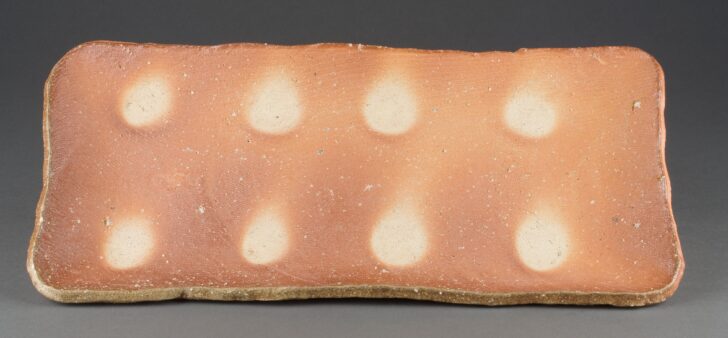Shigaraki ware plate
Takahashi Rakusai III

Description
Takahashi Rakusai III
Japan, 1898–1976
Vase
Showa period (1926–1989)
1960–63
Stoneware with natural ash glaze
Museum purchase, 1963/2.77
Plate
Showa period (1926–1989)
circa 1960
Stoneware with natural ash glaze
Museum purchase, 1963/2.76
Takahashi Rakusai III, who came from a long line of Shigaraki potters, employed the same clay and wood-firing technique used in the jars and vases prized by tea masters of the Momoyama period (1583–1615) to create powerful and whimsical wares for the modern era. Although this vase has a classic form, Takahashi achieves a dynamic effect through the combination of rough surface and green ash glaze. The rectangular plate is more playful: the dots on the unglazed, scorched top are areas that were protected from the flame by cylindrical clay spacers.
(Turning Point exhibition, Spring 2010)
This wonderfully bold plate is by Takahashi Rakusai III, an artist who comes from a long line of Shigaraki potters. Here he employs the same clay, and wood-firing technique that are found in the late sixteenth-century Shigaraki tea jar (on display on the tatami platform), and in his own vase (in the adjacent case)—but with very different results. Thick clay slabs were stacked close together in the kiln, so that the floating ash landed on the edge of the plate facing the flame. The top surface is unglazed clay, scorched to an intense red. The "polka dots" are areas that were protected from the flame by cylindrical clay spacers. The effect is both powerful and whimsical, and utterly modern in sensibility.
Exhibited in "Japanese Costumes & Ceramics, Past & Present," October 2001-February 2002. Maribeth Graybill, Senior Curator of Asian Art
Takahashi Rakusai III was a twentieth-century artist who came from a long line of potters of Shigaraki ware. Here he employed the same clay and wood-firing technique that are found in the late-sixteenth-century Shigaraki jar on display, but to an entirely different effect. The artist stacked thick clay slabs close together in the kiln so that the floating ash would land on the edge of the plate facing the flame. The top surface is unglazed clay, scorched to an intense red. The "polka dots" are areas that were protected from the flame by cylindrical clay spacers. The effect is both powerful and whimsical, and utterly modern in sensibility.
(Label for UMMA Japanese Gallery Opening Rotation, March 2009)
--
Takahashi Rakusai III, who came from a long line of Shigaraki potters, employed the same clay and wood-firing technique used in the jars and vases prized by tea masters of the Momoyama period (1583–1615) to create powerful and whimsical wares for the modern era. Although this vase has a classic form, Takahashi achieves a dynamic effect through the combination of rough surface and green ash glaze. The rectangular plate is more playful: the dots on the unglazed, scorched top are areas that were protected from the flame by cylindrical clay spacers.
(Turning Point exhibition, Spring 2010)
Subject Matter:
The artist employs the clay and wood-firing technique that are found in the late 16th and 17th century Shigaraki ware. The circular marks seen here were originally created by chance from practical solutions: potters put clay spacers so that the ceramics were evenly fired in kilns. But Takahashi deliberately placed spacers here to create these marks. However, the artist was still able to attain whimsical character from unexpected effect of fire.
Physical Description:
A rectangular shaped plate with eight circular patterns. The rim is slightly flared out to create the concave shape. The top surface is unglazed, scorched to an intense red. The bottom does not have foot. In the kiln, the thick clay slabs were stacked close together so that the floating ash landed on the edge of the plate facing the flame. The circular patterns are areas that were protected from the flame by cylinder clay spacers.
Usage Rights:
If you are interested in using an image for a publication, please visit https://umma.umich.edu/request-image/ for more information and to fill out the online Image Rights and Reproductions Request Form.